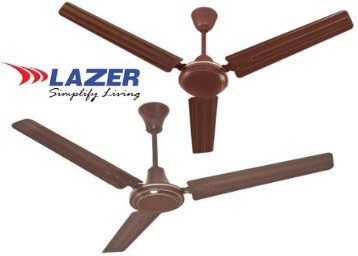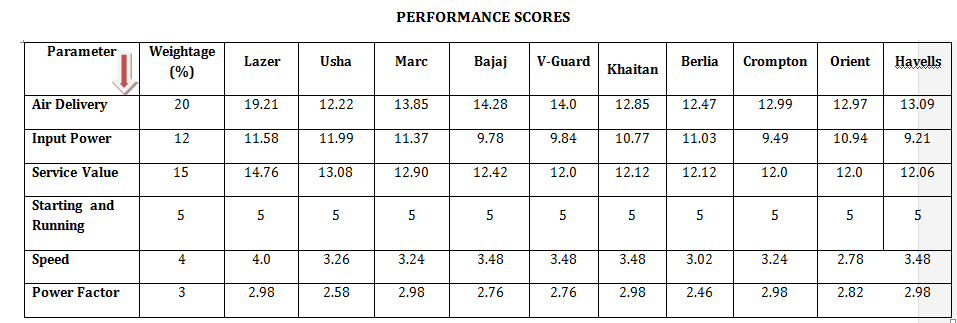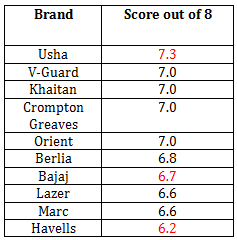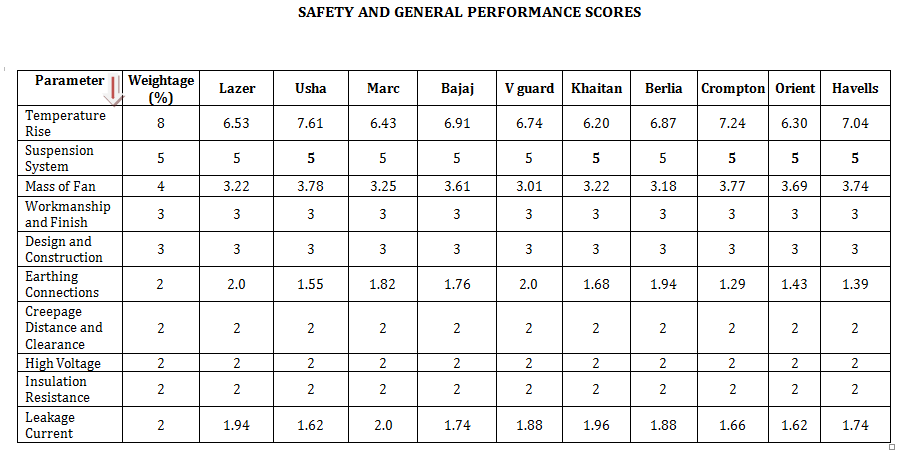In India, ceiling fans are the largest end-use appliance in the residential sector. For so many of us from before the ‘coolers and air conditioners’ era, the ceiling fan was as ubiquitous as the wall—or the ceiling—in the house. It was a generic product that we did not think twice about. It was just, well, there (unless you were a poet or a writer who could conjure up many alternate visions for the ceiling fan whirring on a drowsy Indian summer afternoon). Who really compared the performances of ceiling fans?
Come to think of it, a comparative test on ceiling fans may seem to be a waste of resources and time, since it would have a foregone conclusion. After all, isn’t it a standard product serving a very basic function? Yet, just to give an example, with the millions of ceiling fans sold annually in India, think of the huge amount of electricity being consumed and think of the potential savings in electrical energy that can be realized with energy-efficient motors.
The tests conducted by the Consumer Voice team only considered ceiling fans with five stars (energy-efficiency rating assigned by Bureau of Energy Efficiency, BEE, as per which five stars denote highest efficiency and one star the least). Thus, with energy efficiency as the basic starting point, the tests evaluates 10 leading brands of ceiling fans on parameters that decode their goodness in terms of performance, quality and safety.
A Consumer Voice Report
The test program was based on IS: 374–1979 – specifications for electric ceiling-type fans and regulators. The standard sizes of ceiling fans covered here are 900 mm, 1,050 mm, 1,200 mm, 1,400 mm and 1,500 mm. The test program, though, was limited to 1,200 mm fans – the most commonly used fans – with BEE ratings of five stars. These fans are the regular, non-decorative models with three blades. The tests were conducted at an NABL-accredited laboratory.
[stextbox id=”info” caption=”Protection against Electric Shock”]All the fans were so constructed and enclosed that there was adequate protection against accidental contact with live parts.[/stextbox]
The following report will tell you a thing or two about important criteria like air delivery, service value, power consumption and electrical and mechanical safety. We also considered parameters like silent operation, net weight, and design.
[stextbox id=”info”]The fan, in fact, does not lower room temperature at all; it works by creating a breeze that makes the room feel more comfortable. It helps to circulate the air properly and rotate the air from the top.[/stextbox]
In April this year, Energy Efficiency Services Limited (EESL), a JV of PSUs under the ministry of power, launched a pilot project called National Energy Efficient Fan Programme in Andhra Pradesh. Under this project, two energy-efficient fans are provided to each consumer at Rs 60 a month per fan on EMI basis. The EMI amount will be added to the consumer’s electricity bill for two years.
With the usage of these 50 watts, BEE 5-star-rated ceiling fans, it is estimated that a consumer’s electricity bills will reduce by about Rs 700 to Rs 730 per year. Therefore, the cost recovery of purchasing these fans is less than two years. These fans are 30 per cent more energy-efficient as compared to conventional fans, which range from 75 watts to 80 watts.


[stextbox id=”info” caption=”Key Findings”]
- Based on the overall test findings, lesser known brand Lazer is the top performer followed by Usha and Marc.
- Lazer is also the value-for-money brand.
- All the brands were found to be energy-efficient, consuming between 48.88 watts and 51.25 watts.
- Nine out of 10 brands tested didn’t meet requirement of BEE on air delivery – the key performance parameter.However all brands meet requirement of Indian standard.
- Air delivery was found to be less than 210 m3/min except in the case of Lazer. In order to qualify for BEE’s star rating, it is required that air delivery be not less than 210 m3/min. Higher the ‘air delivery’, better the breeze.
- As per the test results, only Lazer met the requirements of five-star rating in terms of service value (4.46 ), power consumption (48.88 watts) and air delivery (218.03 m3/min). It may be noted that higher the ‘service value’, better the energy efficiency and air delivered. Also, lower the ‘power input’, less the electricity bill.
- All the brands passed in the service value test.
- Only two brands, Lazer and V-Guard, had the ISI mark. However, while both met the requirement of Indian Standards, V-Guard did not meet the requirements of BEE’s five-star rating in terms of air delivery.
- None of the 10 brands provided a standard speed regulator compatible with the fan, often leading to usage of sub-standard regulators by users and thereby possibly affecting the fan’s performance.
- Orient was the heaviest at 3.586 kg; V-Guard weighed the least at only 2.936 kg (motor with blades).
[/stextbox]
Let’s take a look at the test results and
Test results for ceiling fans performance
Air Delivery
Air delivery essentially defines the amount of air a fan delivers – a crucial parameter since it translates into how comfortable you feel sitting under a running fan. As per Indian standard air delivery of a 1,200 mm ceiling fan should be minimum 200 m3/min; however, for a BEE star-rated fan, air delivery should not be less than 210 m3/min.
- All the tested brands met the requirement of Indian Standards.
- Only Lazer met the requirement for a BEE star-rated fan.
Service Value
‘Service value’ denotes the air delivery in metre cube/min, divided by electrical power input to the fan in watts (W) at test voltage and at full speed. In simpler terms, service value means the amount of air delivered per minute per wattage of electricity. As per Indian Standard, the service value of 1,200 mm fans should be minimum 4.0 m3/min/W.
- All brands met the requirement of Indian Standards.
- Again, Lazer scored highest followed by Usha. V-Guard, Crompton and Orient had the minimum score.
Power Input
The power input defines the energy consumption of a fan. Maximum power input for fans of 1,200 mm size shall be a 50 watts as per Indian Standards.
- All the tested brands met the requirement of Indian Standard. They all were found to be energy-efficient, consuming between 48.88 watts and 51.25 watts.
- Usha scored highest on this parameter and Havells the lowest.
Starting and Running
The fan shall be capable of starting from rest when 85 per cent of test voltage or lower limit of voltage range is applied with regulator at lowest speed step.
The performance of all brands was satisfactory on this count.
Speed
Fan speed shall not exceed the +_ 10% of marked value.
- All brands passed in this test. Lazer scored highest on this parameter.
Power Factor
In AC circuits, the power factor is the ratio of the real power that is used to do work and the apparent power that is supplied to the circuit. The power factor can get values in the range of 0 to 1. It shall not be less than 0.90 for ceiling fans.
- All the tested brands met the requirement of Indian Standard.
 Safety and general guidelines
Safety and general guidelines
Temperature Rise | Suspension System | Mass of Fan | Workmanship and Finish | Design and Construction | Earthing Connections | Creepage Distance and Clearance | High Voltage | Insulation Resistance | Leakage Current
- All the tested brands cleared these tests as per the requirements set by Indian Standard.
- The ‘suspension system’ test is to see if the ceiling fan breaks and drops to the ground when subjected to a tensile load of 1,000 kg and torsion load of 500 kg cm.
- Orient was the heaviest fan at 3.586 kg; V-Guard weighed only 2.936 kg.
[stextbox id=”info” caption=”Design and General Construction”]Indian Standards require that the design and general construction of a fan be such that the blades are securely fixed, the material used in fan and regulator are heat- and corrosion-resistant, and there is protection against direct contact with live parts, among other things. All the fans met the requirements for design and general construction.[/stextbox]
General qualities
Marking/Labelling
The container of ceiling fan shall be marked with the following particulars:
a) Manufacturer’s name, trade name (if any) and number
b) Rated voltage(s)/voltage range
c) Type of fan, AC or DC
d) Frequency/frequency range of power supply
e) Air delivery
f) Size of fan
g) Country of manufacture
Other important information to be provided by the Manufacturer covers MRP (in Rs), manufacturing/packing date, standard mark (if any), and warrantee/guarantee. The package shall also include an instruction manual and a warrantee/guarantee card.
- All ceiling-fan brands provided complete marking information.
- Khaitan, Marc, Crompton Greaves and Orient did not have instruction manual.
Packaging
As per Indian Standards, ceiling fans should be packed in strong cardboard box to avoid damage during transportation.
- All ceiling fans were packed in hard carton boxes with thermocol/cardboard supports.

[stextbox id=”info” caption=”CV’s Recommendations”]
1) Indian manufacturers need to put in extra efforts to improve air delivery and service value in order to enable consumers to realise optimal energy savings. Overall, only one brand, Lazer, qualified for BEE’ five-star rating. The remaining nine were found lower on air delivery.
2) There is scope for making ‘super efficient’ fans by bringing down input power by 5 per cent to 10 per cent.
3) A regulator should be capable of reducing the speed of fan to at least 50 per cent. However, none of the 10 brands provided a standard speed regulator compatible with the fan, often leading to usage of sub-standard regulators by users and thereby possibly affecting the fan’s performance.
[/stextbox]
Manufacturers’ Comments
As a matter of policy, before publication the test results of the brands tested are shared with their respective manufacturers/marketers inviting their views/comments. We reproduce here the reactions:

Dear readers: We are open to hearing your suggestions on products and services that you believe should be reviewed/tested by Team Consumer Voice. You may write to [email protected]








A very good verification a clear reporting keep it up
Thank you for your feedback.
Superb article.
Thanks for the detailed info.
very helpful. Thanks for your feedback
You are welcome.
We need more articles like these to sort through misleading marketing. keep up the good work.